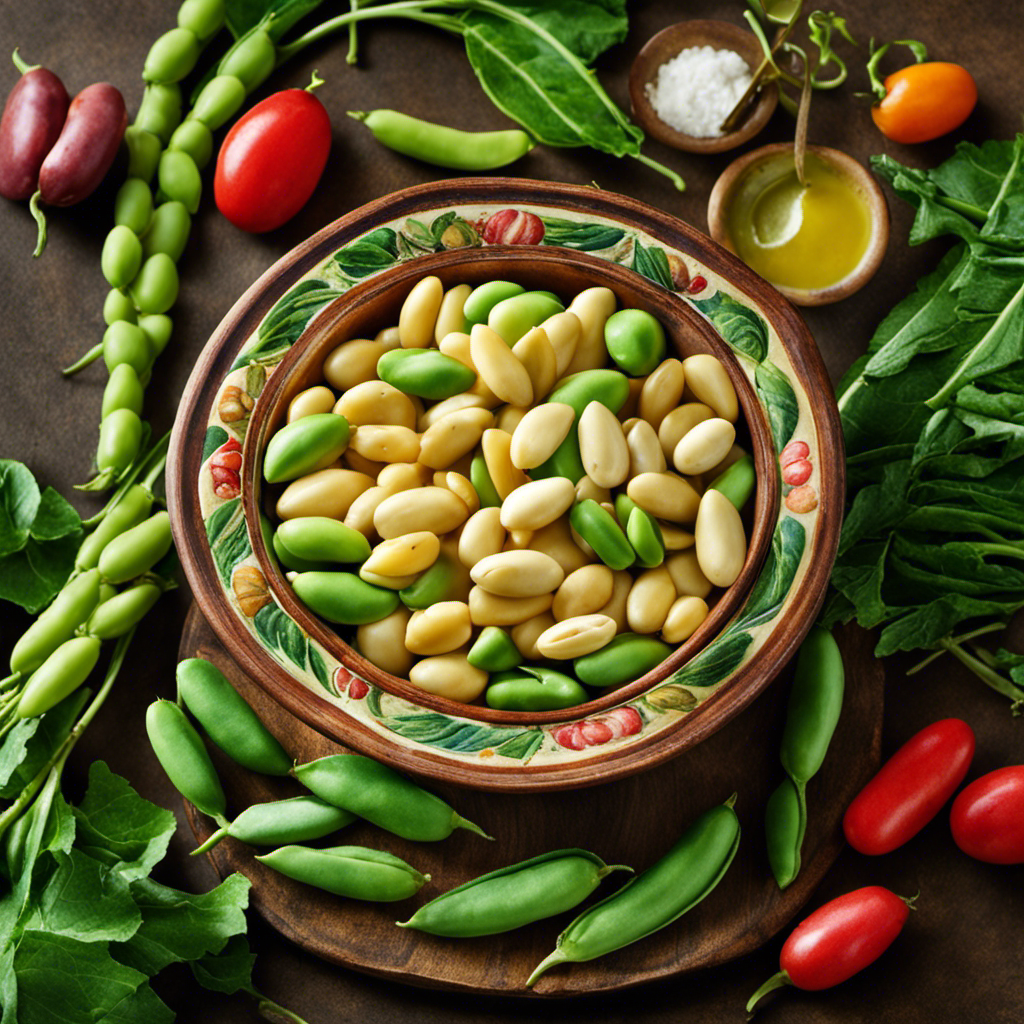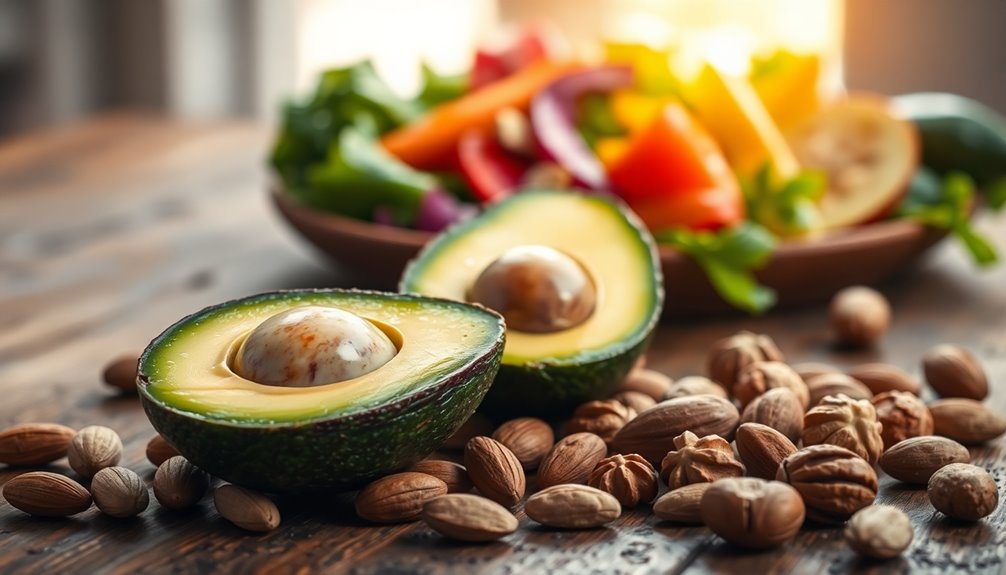I enjoy adding butter beans to my low-carb diet, but I’ve always been curious about the exact carb content of these tasty legumes.
Well, the good news is that butter beans are actually quite low in carbohydrates! In fact, a one-cup serving of cooked butter beans contains only about 40 grams of carbs. This makes them a great option for anyone looking to control their blood sugar levels while still enjoying a nutritious meal.
So, let’s dive into the nutritional profile of butter beans and explore their health benefits together.
Key Takeaways
- Butter beans contain about 40 grams of carbs per cup and are a good source of fiber and protein.
- The high fiber content in butter beans promotes healthy digestion and stable blood sugar levels.
- Butter beans have a low glycemic index, making them suitable for individuals with diabetes or those aiming for stable blood sugar levels.
- Incorporating butter beans into a low-carb diet can provide the benefits of protein, fiber, essential nutrients, and aid in weight management.
The Nutritional Profile of Butter Beans
Butter beans are a great source of fiber and protein. They not only offer many health benefits but are also delicious. One of the key nutrients found in butter beans is dietary fiber. Just one cup of butter beans contains approximately 15 grams of dietary fiber, which is about 60% of the recommended daily intake for adults. This high fiber content helps to promote healthy digestion, prevent constipation, and maintain stable blood sugar levels.
Additionally, butter beans are versatile and can be used in a variety of recipes. From soups and stews to dips and salads, there are countless ways to incorporate butter beans into your meals and enjoy their nutritional benefits.
Carbohydrate Content of Butter Beans
To find out the carbohydrate content of butter beans, you should check the nutrition facts label. Butter beans are a good source of carbohydrates, providing energy for our body. In a 100-gram serving of cooked butter beans, there are approximately 22 grams of carbohydrates.
When compared to other legumes, such as chickpeas or lentils, butter beans have a slightly higher carbohydrate content. However, it’s important to note that carbohydrates have different effects on our blood sugar levels. Butter beans have a low glycemic index, which means they are digested and absorbed slowly, resulting in a gradual rise in blood sugar levels. This makes them a suitable food choice for individuals with diabetes or those looking to maintain stable blood sugar levels.
Now, let’s explore the health benefits of consuming butter beans.
Health Benefits of Consuming Butter Beans
Butter beans are not only delicious but also packed with several essential nutrients. They are a great source of protein, fiber, and vitamins such as folate and iron. Consuming butter beans regularly can promote a healthy digestive system, support heart health, and boost energy levels.
Additionally, they can be cooked in various ways, such as boiling, steaming, or incorporating them into soups and stews, making them a versatile and nutritious addition to any meal.
Nutritional Value of Butter Beans
The nutritional value of butter beans includes being a good source of carbohydrates and fiber. Here are three nutritional benefits of consuming butter beans:
-
High in fiber: Butter beans are rich in dietary fiber, which aids in digestion and helps regulate blood sugar levels. Fiber also promotes a feeling of fullness, making it beneficial for weight management.
-
Packed with protein: Butter beans are an excellent plant-based source of protein. Protein is essential for muscle growth and repair and plays a vital role in various bodily functions.
-
Nutrient-dense: Butter beans are a good source of vitamins and minerals, including folate, iron, magnesium, and potassium. These nutrients support overall health and contribute to the proper functioning of the body.
When it comes to cooking techniques, butter beans can be boiled, steamed, or used in soups, stews, and salads. They have a creamy texture and mild taste, making them versatile for various recipes.
Potential Health Implications
Did you know that consuming butter beans can have potential health implications?
While butter beans are a nutritious addition to any diet, it’s important to be aware of the potential risks associated with their consumption.
One potential risk is the high carbohydrate content of butter beans. A 1-cup serving of cooked butter beans contains around 50 grams of carbohydrates. For individuals following a low-carb or ketogenic diet, this may be a concern.
Additionally, some people may experience digestive issues such as bloating or gas after consuming butter beans. It’s important to listen to your body and consume butter beans in moderation.
The recommended serving size for butter beans is around 1/2 to 1 cup per day, depending on your individual dietary needs and goals.
Cooking and Preparation Methods
When cooking butter beans, it’s important to soak them overnight to help reduce cooking time and improve their texture. Soaking the beans allows them to absorb water and soften, making them easier to cook and enhancing their overall taste and texture.
Once soaked, there are several cooking techniques you can use to prepare butter beans. Here are three popular methods:
-
Boiling: This is the most common method of cooking butter beans. Simply place the soaked beans in a pot, cover them with water, and bring to a boil. Reduce the heat and let them simmer until they are tender.
-
Pressure cooking: Using a pressure cooker can significantly reduce the cooking time of butter beans. It allows for faster and more even cooking, resulting in tender beans in a shorter period.
-
Slow cooking: Slow cooking butter beans results in a creamy and flavorful dish. Place the soaked beans in a slow cooker along with your choice of seasonings and cook on low heat for several hours.
When it comes to flavor pairings, butter beans work well with a variety of ingredients. They can be added to soups, stews, or salads, or paired with herbs and spices like garlic, thyme, and cumin. Additionally, they pair nicely with meats such as bacon, ham, or sausage, adding a hearty and satisfying element to your dishes.
Butter Beans and Blood Sugar Control
If you’re trying to control your blood sugar, you’ll be glad to know that butter beans are a great option due to their low carb content. Blood sugar management is crucial for individuals with diabetes or those looking to maintain stable blood sugar levels.
Butter beans have a low glycemic index, which means they cause a slower rise in blood sugar compared to high glycemic foods. This is because they are rich in fiber and protein, which helps slow down the absorption of glucose in the bloodstream.
Incorporating butter beans into your diet can support better blood sugar control and overall glycemic management. So, whether you’re looking for a tasty side dish or a protein-packed addition to your meals, consider adding butter beans to your plate.
Incorporating Butter Beans Into a Low-Carb Diet
To successfully incorporate butter beans into your low-carb diet, focus on their rich fiber and protein content that can help maintain stable blood sugar levels. Here are three ways you can incorporate butter beans into your low-carb diet:
-
Use butter bean substitutes: If you’re looking to reduce the carb content even further, consider using butter bean substitutes such as cauliflower or zucchini. These vegetables can provide a similar texture and taste, while keeping your carb intake low.
-
Include butter beans in a ketogenic diet: While butter beans are not typically considered a staple in a ketogenic diet due to their higher carb content, they can still be enjoyed in moderation. To fit them into a keto diet, it’s important to track your macros and ensure that you’re not exceeding your daily carb limit.
-
Pair butter beans with low-carb foods: Incorporate butter beans into your meals by pairing them with low-carb foods such as lean proteins, non-starchy vegetables, and healthy fats. This will help balance out the carb content and make it easier to stay within your low-carb goals.
Comparing Carbs in Butter Beans to Other Legumes
You can compare the carbohydrate content of butter beans to other legumes to determine which options align with your low-carb diet goals. When comparing the carb content of legumes, it’s important to consider portion sizes as they can vary.
In general, butter beans have a moderate amount of carbs compared to other legumes. For example, a half cup of cooked butter beans contains about 20 grams of carbs. In comparison, a half cup of black beans contains around 22 grams of carbs, while chickpeas have about 25 grams of carbs in the same portion.
So, if you’re looking for legume alternatives with lower carb content, you might consider options like lentils or green peas, which have around 10 grams of carbs per half cup serving.
Ultimately, it’s important to choose legumes that fit within your desired carb intake while still providing the nutritional benefits they offer.
Delicious Recipes With Butter Beans and Low Carb Options
Looking for some tasty recipes? There are plenty of delicious options that incorporate butter beans while still staying low in carbs. Here are three ideas to get you started:
-
Low Carb Butter Bean Salad: Mix cooked butter beans with diced cucumbers, cherry tomatoes, and red onions. Toss with a dressing made from olive oil, lemon juice, garlic, and herbs. This refreshing salad is packed with nutrients and flavor.
-
Butter Bean Pasta Alternative: Instead of traditional pasta, try using butter beans as a low carb alternative. Mash cooked butter beans and toss them with your favorite pasta sauce. Top with grated Parmesan cheese for a satisfying and filling meal.
-
Butter Bean and Vegetable Stir-Fry: Sauté butter beans with colorful vegetables like bell peppers, zucchini, and mushrooms. Season with soy sauce, garlic, and ginger for a flavorful stir-fry that is both low in carbs and packed with protein.
These recipes show that you don’t have to sacrifice taste or flavor when following a low carb diet. Enjoy the benefits of butter beans while still keeping your carb intake in check.
Frequently Asked Questions
Can Butter Beans Be Consumed by Individuals With Diabetes or Those Who Are Trying to Control Their Blood Sugar Levels?
Butter beans can be a good option for those with diabetes or trying to control blood sugar levels. They have a low glycemic index, which means they have a minimal impact on blood sugar. Additionally, they are rich in fiber, protein, and nutrients, making them beneficial for weight loss.
Are Butter Beans Suitable for Individuals Following a Low-Carb Diet?
Butter beans are a staple in Mediterranean cuisine. They are a great source of protein for low-carb diets. Incorporating them into your meals can provide a delicious and healthy alternative to other high-carb options.
How Do the Carbohydrate Levels in Butter Beans Compare to Other Legumes?
When comparing the carbohydrate levels in other legumes, it’s important to consider the nutritional value of butter beans. They may contain more or less carbs depending on the specific legume, but they generally provide a good source of fiber and protein.
Are There Any Health Benefits Associated With Consuming Butter Beans?
Eating butter beans can have numerous health benefits due to their high nutritional value. They are packed with fiber, protein, and essential vitamins and minerals. Incorporating butter beans into your diet can support overall health and wellbeing.
Can You Provide Some Delicious Recipes Using Butter Beans That Are Low in Carbs?
Sure, I can provide some delicious low-carb recipes using butter beans. Including butter beans in your diet has many benefits, such as being a good source of protein and fiber.
Conclusion
In conclusion, butter beans are a nutritious and versatile legume that can be enjoyed as part of a low-carb diet. They have a low carbohydrate content and high fiber content, which can help regulate blood sugar levels and promote overall health.
Incorporating butter beans into your meals not only adds flavor and texture, but also provides essential nutrients. So, next time you’re looking for a delicious and healthy option, consider trying out some of the amazing recipes featuring butter beans.
Your taste buds and your body will thank you!










